A histidine aspartate ionic lock gates the iron passage in miniferritins from Mycobacterium smegmatis
- PMID: 24573673
- PMCID: PMC4036245
- DOI: 10.1074/jbc.M113.524421
A histidine aspartate ionic lock gates the iron passage in miniferritins from Mycobacterium smegmatis
Abstract
Dps (DNA-binding protein from starved cells) are dodecameric assemblies belonging to the ferritin family that can bind DNA, carry out ferroxidation, and store iron in their shells. The ferritin-like trimeric pore harbors the channel for the entry and exit of iron. By representing the structure of Dps as a network we have identified a charge-driven interface formed by a histidine aspartate cluster at the pore interface unique to Mycobacterium smegmatis Dps protein, MsDps2. Site-directed mutagenesis was employed to generate mutants to disrupt the charged interactions. Kinetics of iron uptake/release of the wild type and mutants were compared. Crystal structures were solved at a resolution of 1.8-2.2 Å for the various mutants to compare structural alterations vis à vis the wild type protein. The substitutions at the pore interface resulted in alterations in the side chain conformations leading to an overall weakening of the interface network, especially in cases of substitutions that alter the charge at the pore interface. Contrary to earlier findings where conserved aspartate residues were found crucial for iron release, we propose here that in the case of MsDps2, it is the interplay of negative-positive potentials at the pore that enables proper functioning of the protein. In similar studies in ferritins, negative and positive patches near the iron exit pore were found to be important in iron uptake/release kinetics. The unique ionic cluster in MsDps2 makes it a suitable candidate to act as nano-delivery vehicle, as these gated pores can be manipulated to exhibit conformations allowing for slow or fast rates of iron release.
Keywords: DNA-binding Protein; Ion Channels; Ionic Cluster; Iron; Iron Oxidation; Mycobacterium; Mycobacterium smegmatis; X-ray Crystallography.
Figures
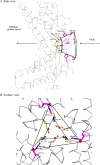
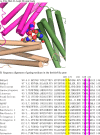
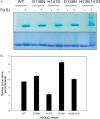
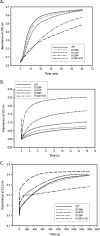
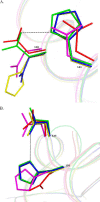
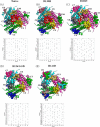
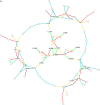


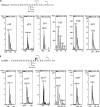

Similar articles
-
Flexible aspartates propel iron to the ferroxidation sites along pathways stabilized by a conserved arginine in Dps proteins from Mycobacterium smegmatis.Metallomics. 2017 Jun 21;9(6):685-698. doi: 10.1039/c7mt00008a. Metallomics. 2017. PMID: 28418062
-
Structural studies on the second Mycobacterium smegmatis Dps: invariant and variable features of structure, assembly and function.J Mol Biol. 2008 Jan 25;375(4):948-59. doi: 10.1016/j.jmb.2007.10.023. Epub 2007 Oct 16. J Mol Biol. 2008. PMID: 18061613
-
Role of N and C-terminal tails in DNA binding and assembly in Dps: structural studies of Mycobacterium smegmatis Dps deletion mutants.J Mol Biol. 2007 Jul 20;370(4):752-67. doi: 10.1016/j.jmb.2007.05.004. Epub 2007 May 10. J Mol Biol. 2007. PMID: 17543333
-
Cryo-EM Reveals the Mechanism of DNA Compaction by Mycobacterium smegmatis Dps2.J Mol Biol. 2024 Nov 1;436(21):168806. doi: 10.1016/j.jmb.2024.168806. Epub 2024 Sep 28. J Mol Biol. 2024. PMID: 39349276 Review.
-
Mycobacterial porins--new channel proteins in unique outer membranes.Mol Microbiol. 2003 Sep;49(5):1167-77. doi: 10.1046/j.1365-2958.2003.03662.x. Mol Microbiol. 2003. PMID: 12940978 Review.
Cited by
-
The Dps4 from Nostoc punctiforme ATCC 29133 is a member of His-type FOC containing Dps protein class that can be broadly found among cyanobacteria.PLoS One. 2019 Aug 1;14(8):e0218300. doi: 10.1371/journal.pone.0218300. eCollection 2019. PLoS One. 2019. PMID: 31369577 Free PMC article.
-
Rational pore engineering reveals the relative contribution of enzymatic sites and self-assembly towards rapid ferroxidase activity and mineralization: impact of electrostatic guiding and cage-confinement in bacterioferritin.Chem Sci. 2025 Jan 20;16(9):3978-3997. doi: 10.1039/d4sc07021f. eCollection 2025 Feb 26. Chem Sci. 2025. PMID: 39886445 Free PMC article.
-
An Overview of Dps: Dual Acting Nanovehicles in Prokaryotes with DNA Binding and Ferroxidation Properties.Subcell Biochem. 2021;96:177-216. doi: 10.1007/978-3-030-58971-4_3. Subcell Biochem. 2021. PMID: 33252729 Review.
-
Dps Functions as a Key Player in Bacterial Iron Homeostasis.ACS Omega. 2023 Sep 11;8(38):34299-34309. doi: 10.1021/acsomega.3c03277. eCollection 2023 Sep 26. ACS Omega. 2023. PMID: 37779979 Free PMC article. Review.
-
A ferritin-like protein with antioxidant activity in Ureaplasma urealyticum.BMC Microbiol. 2015 Jul 26;15:145. doi: 10.1186/s12866-015-0485-6. BMC Microbiol. 2015. PMID: 26209240 Free PMC article.
References
-
- Aisen P., Enns C., Wessling-Resnick M. (2001) Chemistry and biology of eukaryotic iron metabolism. Int. J. Biochem. Cell Biol. 33, 940–959 - PubMed
-
- Benjamin J. A., Desnoyers G., Morissette A., Salvail H., Massé E. (2010) Dealing with oxidative stress and iron starvation in microorganisms: an overview. Can. J. Physiol. Pharmacol. 88, 264–272 - PubMed
-
- Bozzi M., Mignogna G., Stefanini S., Barra D., Longhi C., Valenti P., Chiancone E. (1997) A novel non-heme iron-binding ferritin related to the DNA-binding proteins of the Dps family in Listeria innocua. J. Biol. Chem. 272, 3259–3265 - PubMed
-
- Zhao G., Ceci P., Ilari A., Giangiacomo L., Laue T. M., Chiancone E., Chasteen N. D. (2002) Iron and hydrogen peroxide detoxification properties of DNA-binding protein from starved cells. A ferritin-like DNA-binding protein of Escherichia coli. J. Biol. Chem. 277, 27689–27696 - PubMed
Publication types
MeSH terms
Substances
LinkOut - more resources
Full Text Sources
Other Literature Sources
Medical

